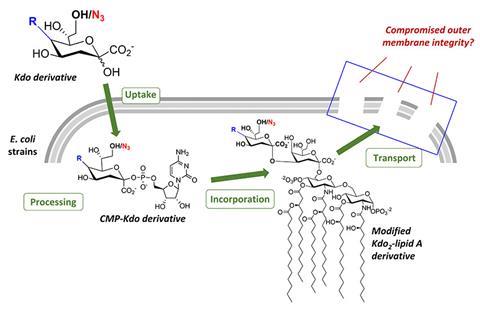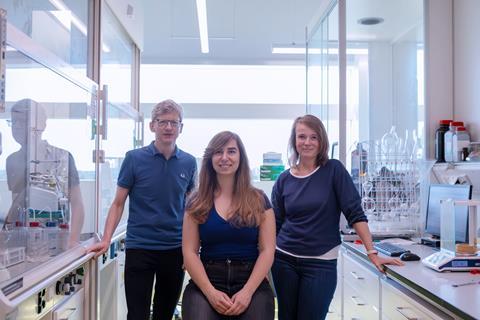Researchers in Groningen have synthesised a variant of a sugar molecule that is incorporated in the cell wall of Gram-negative bacteria. However, as reported in JACS Au, they did not achieve the desired effect.
In view of antibiotic resistance, the search for new ways to render bacteria harmless is ongoing. One interesting target for Gram-negative bacteria is their cell wall, which consists of two membranes separated by a layer of peptidoglycan. On the outside of the outer membrane is a layer of lipopolysaccharides (LPS). Disrupting the cell wall from the inside makes the bacteria more sensitive to antibiotics. Zeynep Su Ziylan, Marthe Walvoort and their colleagues at the University of Groningen have successfully achieved this using a derivative of the sugar molecule 3-deoxy-d-manno-oct-2-ulosonic acid (Kdo). Well, almost successfully.
Nightmare
‘The first paper on the use of the Kdo derivative 8-azido-Kdo was published ten years ago’, says Marthe Walvoort, associate professor of chemical glycobiology. When this derivative is brought into contact with a bacterium, it is metabolised into the LPS. ‘It’s a very strange sugar with eight carbon atoms. In Zeynep’s PhD project, she created variations on Kdo with the aim of disrupting the LPS structure in this way.’ The hypothesis was that this would result in a shortened or truncated LPS, which would weaken the bacteria and hopefully lead to a permeable membrane.
However, the synthesis ‘is a nightmare, just terrible’, laughs Walvoort. ‘It took much longer because all kinds of isomers were formed, and purification was difficult.’ Nevertheless, it worked, and the most successful molecule in Ziylan’s synthesised library was 5-epi-Kdo-8-N3.

This molecule was indeed incorporated into the lipopolysaccharide structure by the model bacterium (E. coli). ‘Just not at the crucial point! Apparently, there are two Kdos in E. coli: one at the crucial point where the LPS is built upon and one next to it’, explains Walvoort. ‘So our molecule is probably incorporated at position two, which means it has no impact on the sugars that need to be added further on in the LPS.’
The initial goal has therefore not been achieved. However, there is now a better understanding of the labelling process, and of why the bacterium absorbs this derivative and not the other one, which lacks the hydroxy group at position 5.
Community
Once the manuscript had been submitted and was going through the review process, something in an NMR spectrum appeared to be incorrect. Walvoort was in Vienna at a conference when she bumped into Paul Kosma, ‘one of the founding fathers of sugar chemistry’. ‘He helped us a lot because he discovered that one of the NMR spectra showed a completely different molecule to the one we thought.’
One of the labelled Kdo variants had undergone recombination. ‘The reviewer had picked up that the assignment was incorrect, and coincidentally, Paul Kosma had also noticed this’, says Walvoort. ’He then helped us to assign the correct structure. I really felt supported by the community during the review phase. It’s nice when you realise that people want to help improve the paper rather than you having to prove yourself.’
Continue reading below the image

Walvoort also thinks it’s ’cool that you can still collaborate at that stage of publication’. ‘It taught me that you can approach people who have long since retired for help. I should have asked for help much earlier, but better late than never, I suppose.’
The interdisciplinary nature of this work is important to Walvoort. ‘We received funding from the faculty specifically for people from two different institutes, which makes this kind of blue-sky research possible.’ This also applies to the future. ‘It creates fertile ground for future collaborations. There are many things that you can’t measure, but which are very valuable, and this is a wonderful example of that.’
Model
This paper also marks the end of Ziylan’s PhD, and there is no immediate prospect of follow-up funding. ‘I would very much like to keep going’, says Walvoort. ‘But there is no one who can continue the work.’ What if she could continue? ’Then I would label Haemophilus influenzae bacteria with our molecule. There is only one place where Kdo is present in the LPS, so it has to form a shortened LPS.’
She laughs, ’E. coli wasn’t such a good model bacterium after all.’
‘That’s what I find so fascinating about this field’, she concludes. ‘The tension between wanting your sugar molecules to resemble the original sugars as much as possible so that they are absorbed and incorporated, while also ensuring that your molecule has a disruptive effect.’

Ziylan, Z. et al. (2025) JACS Au, DOI: 10.1021/jacsau.5c00338













Nog geen opmerkingen